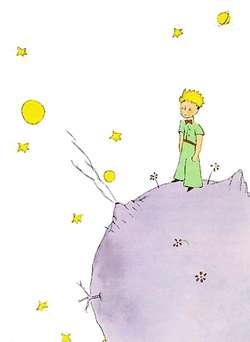The Little Prince

"Goodbye," said the fox. "And now here is my secret, a very simple secret: it is only with the heart that one can see rightly; what is essential is invisible to the eye."
A worldwide literary classic (it's been translated into 190 languages), The Little Prince (Le Petit Prince in French) is a 1943 children's book written by French aviator and count Antoine De Saint Exupery. It is the fictional account of a French aviator whose plane crashes in the Sahara desert, a thousand miles from civilization. He is approached by a young prince who requests that he draw him a sheep, which leads into the prince describing to the narrator his life on an asteroid and his travels from planet to planet in search of the meaning of life, the universe, and everything. While the book was written for children, the philosophical content appeals to any adult reader, as during the prince's adventures he encounters analogues of many of the traits of modern humanity, and learns about love and friendship from the plants and animals he meets.
Adaptations have mostly been for the stage, but there's also a 1974 movie musical and a 1979 Claymation short. It also inspired an anime. There is also a new CGI cartoon, airing on French TV, called The New Adventures of the Little Prince.
The book was adapted into a full-length animated movie in 2015. On an interesting note, the concept art was done by Thurop van Orman, the director of The Marvelous Misadventures of Flapjack.
The story is in the public domain, and can be read in its entirety here.
Not in any way a Spear Counterpart to A Little Princess.
- Adults Are Useless: A recurring theme is that adults do not understand what is really important in life, do not know what they are really looking for, and are obsessed with numbers to the point of insanity.
- Author Avatar: The Narrator who meets the little prince.
- The little prince himself bears some resemblance to the author as a child.
- Baby Planet
- Bittersweet Ending
- A Boy and His X: First a Boy and his Rose, later a Boy and his Fox.
- And don't forget the sheep!
- Canon Illustrations
- A Child Shall Lead Them
- Companion Cube: The rose.
- Crying Little Kid
- Children Are Innocent
- Constantly Curious
- Cunning Like a Fox: Strangely, although the fox is very worldly-wise, it isn't cunning or even particularly self-interested.
- Drowning My Sorrows: One planet the Prince visits is inhabited by a Tippler caught in a vicious cycle; he claims he drinks to forget that he's ashamed of his drinking habit.
- Growing Up Sucks: "The grown-ups are certainly very odd..."
- Have a Gay Old Time: In Katherine Woods' translation: "What a queer planet!"
- Historical In-Joke: A reference is made to Mustafa Kemal Atatürk and his Westernization policies at one point.
- Literary Agent Hypothesis
- Love Hurts: And how.
- No Name Given / Everyone Calls Him "Barkeep": None of the characters in the story have names, including the Narrator and the title character.
- Numbered Homeworld: Asteroid B-612.
- The planets the prince visits are all numbered, as well.
- Planet of Hats: In fact, every planet we meet is solely inhabited by one person (except for Earth).
- The Geographer's planet is vast like the Earth, but we never see enough of it to know if he is the only inhabitant. The King's planet may or may not have a rat on it.
- Planetville: Read above.
- Playing Pictionary: The narrator explains how he once drew a picture of a snake that had swallowed an elephant, and all the adults told him it was a very nice hat.
- Real Life Writes the Plot: The book can be also seen as a stealth autobiography. It's based on the time Saint-Exupéry was stuck in the desert for months. See his other novel Wind Sand and Stars.
- Reptiles Are Abhorrent: Played with. The Snake is seen as evil by the narrator, but not by the Little Prince: "You have good poison? You are sure that it will not make me suffer too long?"
- Small Secluded World: Most of the places he visits, Played for symbolism.
- Something About a Rose
- Too Good for This Sinful Earth
- Tsundere: The rose.
- Walking the Earth: More like traveling through the stars.
- The Wise Prince: This is an interesting case of this, since the only person under his command is a flower, and while he knows a lot about life in the sky, he's rather inexperienced outside of his kingdom. He does hit the melancholy, kind, honourable, and well-intentioned markers face first, and his inexperience is minimal compared to the various adults.
The New Adventures of the Little Prince contains examples of:
- An Aesop: Because children are a part of its target audience.
- A Boy and His X: A Boy and His Fox.
- Lethal Lava Land: The Planet of the Firebird becomes this after said bird goes on a rampage.
- Planet of Hats: Planet of Wind, Planet of Music, etc.
- Time Master: The Planet of Time has The Clockmaker, who governs all the clocks on the planet, and with them, has some control over time.
- Time Stands Still: On The Planet of Time, each town's time is self-contained and is controlled by the town's clock. Stopping that clock leaves its inhabitants frozen in time.
- Wind Turbine Power: The inhabitants of The Planet of Wind have based their entire society on wind. Most of their devices are powered by wind.